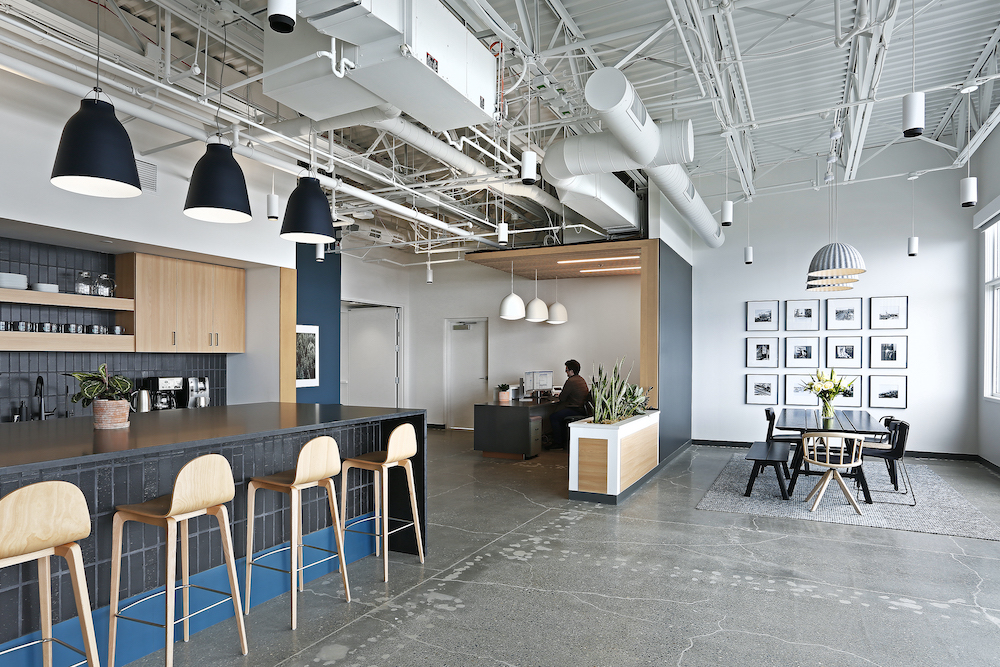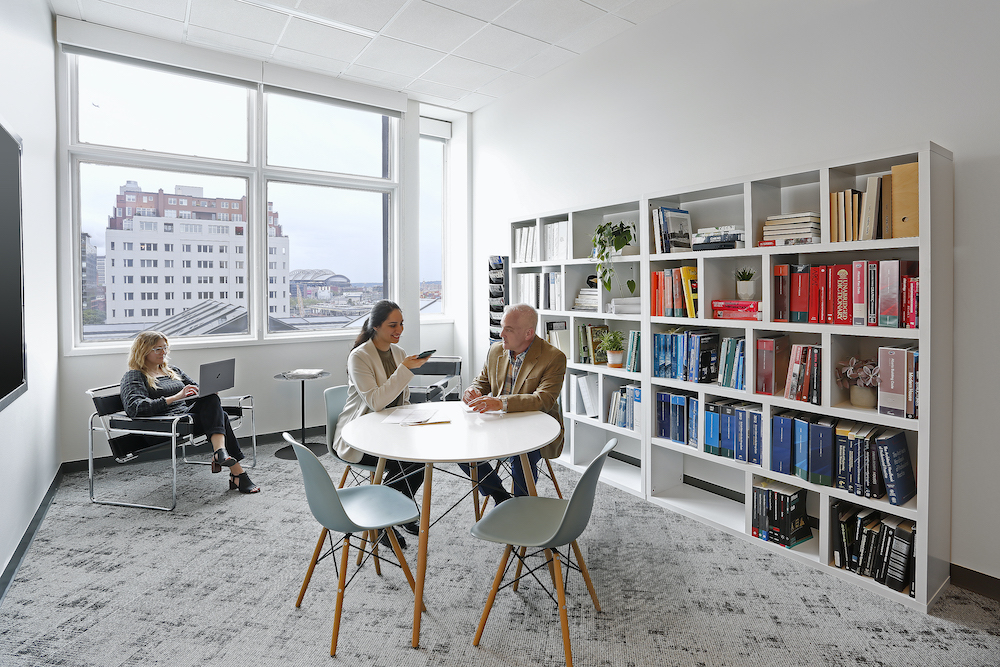In response to the adoption of a flexible work policy, Cushing Terrell’s new Seattle workspace emphasizes agency through a variety of spaces and amenities.

Cushing Terrell’s 9,000-square-foot Seattle office, located in the penthouse of a historic warehouse building, boasts uninterrupted views of the downtown waterfront and Olympic mountains, drawing inspiration from the moody hues and varied textures of the Puget Sound and Pacific Northwest coastline.
The goal of the project was to create an efficient flow of people and activities throughout the space, while ensuring collaborative, equitable, and inspiring touch-down areas for the diverse roles and responsibilities of the team members who would be using the space. Additionally, the design prioritized thoughtful repurposing of resources. From the adaptive reuse of the century-old building to conference tables and workspace storage carried over from the previous office, the team set out to modernize the workspace consciously and thoughtfully.

Project Overview:
- Design Firm: Cushing Terrell
- Completion Date: 2022
- Location: Seattle, WA, USA
- Size: 9,000 sqft (interior) + 1,200 sqft rooftop deck (exterior)
- Population: 38
The existing floor plate was preserved but reconfigured with a space plan to emphasize flow and transitions. Buzzy zones of activity were intentionally linked together, removed from quieter, focused workspaces. Guests are greeted at the elevator lobby with a warm, neutral sign and welcomed into a series of gathering spaces, including a living room, private 1,200-square-foot rooftop deck, dining room, and open kitchen space.
Where once were small, private offices, an open kitchen and dining room have emerged. As a part of the renovation, the separating walls were removed to expose floor-to-ceiling windows, revealing the office’s greatest asset: views of the surrounding geography.
Adjacent to the breakroom, situated behind large, sliding glass doors, is the design lab. An extension of the community gathering space, the design lab encourages collaborative, creative problem-solving with the benefit of a full library of materials and resources.


In addition to repurposing the space itself, heavy emphasis was placed on the responsible reuse and/or disposal of assets from a previous workspace. A series of workstation storage units were retained and repainted to match the new sit-stand desks, and a large conference table was relocated to anchor one of the new space’s largest meeting rooms. Other items were redistributed throughout the community by resale or donation, and material samples were returned to local manufacturers to divert as much of the furniture, materials, and supplies from the landfill as possible.
The concept of reuse extended beyond existing assets into key new furniture items and fixtures as well. Among those were the dining table, which was saved from a decommissioned showroom closed during the pandemic; task chairs made with reclaimed ocean plastic; and a Living Product Challenge certified woven area rug made from 100% recycled plastic water bottles, featured in the dining room.

The entire design process was carried out amid the COVID-19 pandemic, which resulted in unique challenges and fine tunings. Knowing firsthand the pandemic had changed and would continue to change the way offices are used, special consideration was given to this new space to ensure it served as an asset for the new way the team would work and provided agency with a variety of spaces to accommodate a range of workday needs.

Project Planning
When designing the new office space for Cushing Terrell’s own multi-disciplinary design team, it was important to have the team’s input. As designers and subject matter experts, every team member was a stakeholder. With that framework in mind, an effort was made to ensure the team felt they were part of the process from the beginning. One of the first things Cushing Terrell did was come together for a charrette where the team was asked what the new office will look like and what they needed out of a new workspace. All team members, not just the designers and architects, but the entire staff, came together and had a voice in the design. Being able to include all these various teammates meant the team all felt like they had a hand in the project and feels at home in the new space—from architects to designers to engineers and corporate team as well.


Project Details & Products
- Carpet: Mohawk
- Interior Glazing: Carvart Glass
- Furniture Lines: Pair, Hightower, Ondarreta, Humanscale, Pedrali, BuzziSpace, Stylex, RAD
- Tile: Fireclay
- Quartz: Caesarstone, Cambria
- Plastic Laminate: Abet Laminati
- Textiles: KnollTextiles, Maharam
- Decorative Lighting: Hightower, Rich Brilliant Willing, Graypants, Muuto
- Acoustical Felt: FeltRight
- Wood Slats: 9Wood

Overall Project Results
With a few months of use under their belts, Cushing Terrell is observing that the buzzy, collaborative spaces are the most utilized, even more than the dedicated workstations in the open office area. For those that work a hybrid schedule, or even a mostly remote one, the collaborative spaces function as a motivator to still come in to take advantage of the design lab, conference rooms, and social spaces. This has validated Cushing Terrell’s decision to use so much of the space for these buzzy zones, but has also given them some additional first-hand experience with the shift in workplace priorities, needs, and use cases.

Project Summary
Project Team
- Architecture/Interiors: Cushing Terrell
- Contractor: Abbott Construction
Cushing Terrell Design Team
- Kara Eberle, Project Manager
- Jessica Earp, Design Lead
- Isaura Perez, Architecture
Photography
- Mark Woods Photography



Love the design of this office and all the thought that was put into it!